Articles
- Page Path
- HOME > J Musculoskelet Trauma > Volume 30(3); 2017 > Article
-
Case Report
- Atypical Fracture-Like Insufficiency Fracture of the Tibia with Prolonged Bisphosphonate Drug: A Case Report
-
Min Jung Park, M.D.
 , Su Jin Lee, M.D.
, Su Jin Lee, M.D. , Jin Hwa Kam, M.D.
, Jin Hwa Kam, M.D. , Yun Tae Lee, M.D.
, Yun Tae Lee, M.D. , Ju Hyung Yoo, M.D.
, Ju Hyung Yoo, M.D. , Hyun Cheol Oh, M.D.
, Hyun Cheol Oh, M.D. , Joong Won Ha, M.D.
, Joong Won Ha, M.D. , Yung Park, M.D.
, Yung Park, M.D. , Sang Hoon Park, M.D.
, Sang Hoon Park, M.D. , Seong Hoon Kim, M.D.
, Seong Hoon Kim, M.D. , Han Kook Yoon, M.D.
, Han Kook Yoon, M.D.
-
Journal of the Korean Fracture Society 2017;30(3):137-141.
DOI: https://doi.org/10.12671/jkfs.2017.30.3.137
Published online: July 21, 2017
Department of Orthopaedic Surgery, National Health Insurance Service Ilsan Hospital, Goyang, Korea.
*Department of Internal Medicine, National Health Insurance Service Ilsan Hospital, Goyang, Korea.
†Department of Orthopaedic Surgery, Yonsei University College of Medicine, Seoul, Korea.
- Correspondence to: Han Kook Yoon, M.D. Department of Orthopaedic Surgery, National Health Insurance Service Ilsan Hospital, 100 Ilsan-ro, Ilsandong-gu, Goyang 10444, Korea. Tel: +82-31-900-0540, Fax: +82-31-900-0343, hangugi@gmail.com
• Received: February 20, 2017 • Revised: March 13, 2017 • Accepted: April 5, 2017
Copyright © 2017 The Korean Fracture Society. All rights reserved.
This is an Open Access article distributed under the terms of the Creative Commons Attribution Non-Commercial License (http://creativecommons.org/licenses/by-nc/4.0) which permits unrestricted non-commercial use, distribution, and reproduction in any medium, provided the original work is properly cited.
- 468 Views
- 2 Download
- 1 Crossref
Abstract
- Atypical femoral fracture related to a long-term bisphosphonate therapy has commonly been reported; however, a fracture at the site other than the femur has rarely been reported to date. Herein, we report a case of a patient on long-term bisphosphonate therapy who presented atypical tibial insufficiency fracture at the anterolateral aspect of diaphysis, without trauma. We, for the first time in Korea, present this case with a literature review.
- 1. Park JM, Sung KS. Stress fractures of the tibia. Arthrosc Orthop Sports Med, 2015;2:95-102.Article
- 2. Bone HG, Hosking D, Devogelaer JP, et al. Ten years' experience with alendronate for osteoporosis in postmenopausal women. N Engl J Med, 2004;350:1189-1199.Article
- 3. Shane E, Burr D, Abrahamsen B, et al. Atypical subtrochanteric and diaphyseal femoral fractures: second report of a task force of the American Society for Bone and Mineral Research. J Bone Miner Res, 2014;29:1-23.
- 4. Yang KH, Min BW, Ha YC. Atypical femoral fracture: 2015 position statement of the Korean Society for Bone and Mineral Research. J Bone Metab, 2015;22:87-91.Article
- 5. Rogers MJ, Crockett JC, Coxon FP, Mönkkönen J. Biochemical and molecular mechanisms of action of bisphosphonates. Bone, 2011;49:34-41.Article
- 6. Moon J, Bither N, Lee T. Atypical forearm fractures associated with long-term use of bisphosphonate. Arch Orthop Trauma Surg, 2013;133:889-892.ArticlePDF
- 7. Beals RK, Cook RD. Stress fractures of the anterior tibial diaphysis. Orthopedics, 1991;14:869-875.Article
- 8. Bissonnette L, April PM, Dumais R, Boire G, Roux S. Atypical fracture of the tibial diaphysis associated with bisphosphonate therapy: a case report. Bone, 2013;56:406-409.Article
- 9. Odvina CV, Levy S, Rao S, Zerwekh JE, Rao DS. Unusual mid-shaft fractures during long-term bisphosphonate therapy. Clin Endocrinol (Oxf), 2010;72:161-168.Article
- 10. Breglia MD, Carter JD. Atypical insufficiency fracture of the tibia associated with long-term bisphosphonate therapy. J Clin Rheumatol, 2010;16:76-78.Article
REFERENCES
Fig. 1
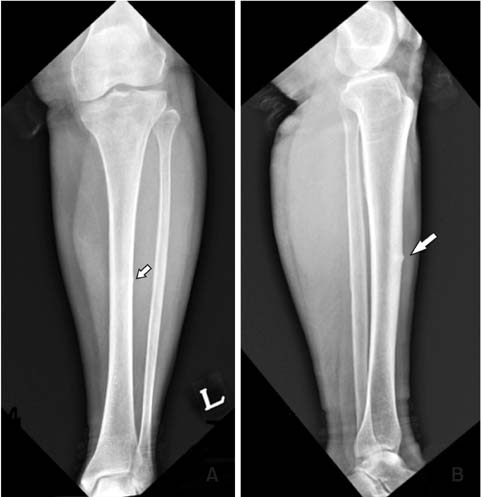
Preoperative radiograph shows atypical tibial diaphyseal fracture (white arrows), including periosteal reaction, endosteal thickening, and a radiolucent fracture line.

Fig. 2
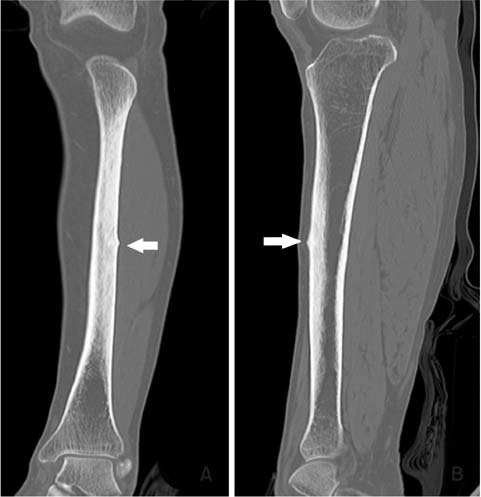
Preoperative computed tomography shows periosteal reaction, cortical thickening, and transverse fracture line (white arrows).

Figure & Data
REFERENCES
Citations
Citations to this article as recorded by 

- Atypical Femoral Fracture Occurring at a Proximal Screw Insertion Site after Plate Removal in a Distal Femoral Fracture
Jin Woo Jin, Sung Jin Shin, Jong Min Jeon
Journal of the Korean Orthopaedic Association.2024; 59(4): 314. CrossRef
Atypical Fracture-Like Insufficiency Fracture of the Tibia with Prolonged Bisphosphonate Drug: A Case Report


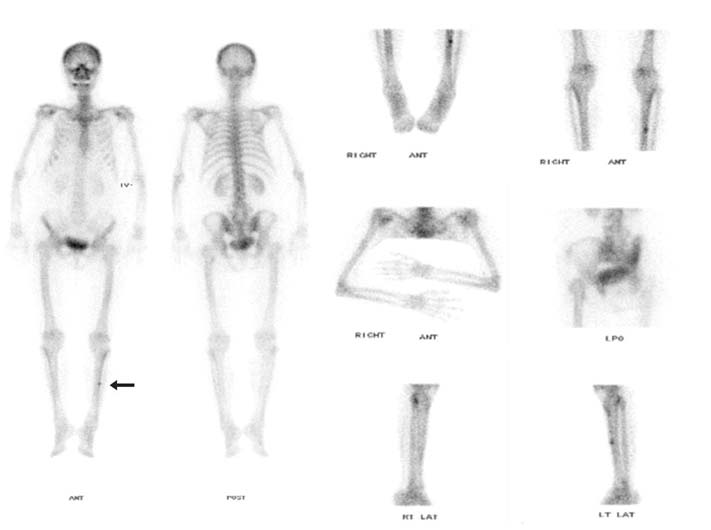
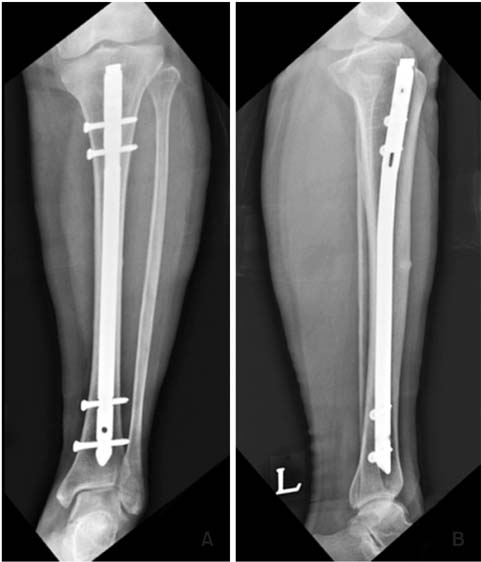
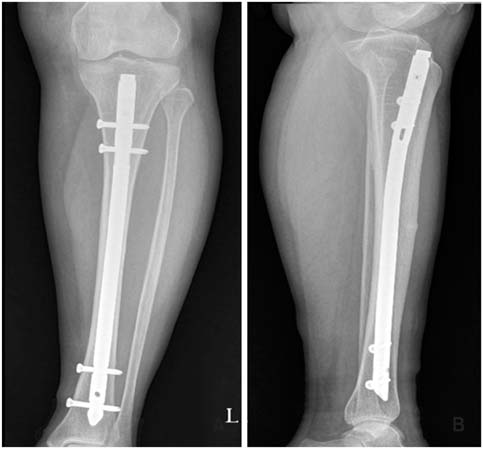
Fig. 1
Preoperative radiograph shows atypical tibial diaphyseal fracture (white arrows), including periosteal reaction, endosteal thickening, and a radiolucent fracture line.
Fig. 2
Preoperative computed tomography shows periosteal reaction, cortical thickening, and transverse fracture line (white arrows).
Fig. 3
Bone scan of this patient shows increased uptake (arrow) at the anterolateral area of tibial diaphysis.
Fig. 4
Using intramedullary nailing, operation was performed.
Fig. 5
The radiographs of tibia taken eight months after the operation show callus formation at the fracture site, with a diminished gap of fracture.
Fig. 1
Fig. 2
Fig. 3
Fig. 4
Fig. 5
Atypical Fracture-Like Insufficiency Fracture of the Tibia with Prolonged Bisphosphonate Drug: A Case Report

 E-submission
E-submission KOTA
KOTA TOTA
TOTA TOTS
TOTS



 Cite
Cite

